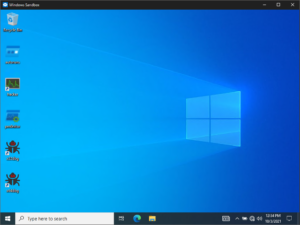**Disclaimer:** If you are not running Windows on your host, you might not get anything out of this post. Sorry Tux.
I am convinced that the Windows Sandbox is one of the best virtualization solutions to do dynamic malware analysis (for Windows malware, at least). The reason is quite simple: Distinguishing a Windows 10 Sandbox instance from the actual underlying Windows 10 install should be very difficult for malware. Specifically if the host is running on HyperV with Guarded Host enabled, my current understanding is that there are little to no differences between the two, but they are neatly isolated from one another. The configuration options are limited, but you can easily cook up a config that launches a WindowsSandbox instance that has all the tools you need for some basic unpacking & dynamic analysis. This is what my malware analysis sandbox looks like at launch:
 I have successfully executed a number of samples that evade execution in other virtualized environments. That's a far cry from rigorous testing, so take my praise with a grain of salt. Still, it might be worth a try, the setup is really easy. Do you want to see my config?
I have successfully executed a number of samples that evade execution in other virtualized environments. That's a far cry from rigorous testing, so take my praise with a grain of salt. Still, it might be worth a try, the setup is really easy. Do you want to see my config?
 I have successfully executed a number of samples that evade execution in other virtualized environments. That's a far cry from rigorous testing, so take my praise with a grain of salt. Still, it might be worth a try, the setup is really easy. Do you want to see my config?
I have successfully executed a number of samples that evade execution in other virtualized environments. That's a far cry from rigorous testing, so take my praise with a grain of salt. Still, it might be worth a try, the setup is really easy. Do you want to see my config?